Welcome, turkey newbies, to your first bird-cooking experience! Whether you’re just at that age where it’s time to take up the mantle of hosting Thanksgiving or you’ve been thrown into the role because of a changing of the guard, now’s the time to show your stuff — and stuff that bird (or rather, don’t, but we’ll get to that).
Cooking a turkey is an epic feat, one to which you’ll need to dedicate hours, if not days. Along the way, there will be plenty of opportunities for mishaps. But with a little planning and a little courage, you might get through this milestone culinary endeavor in-tact. This is the Mandatory Thanksgiving guide to cooking your first bird (and everything that will go wrong along the way)!
Cover Photo: skynesher (Getty Images)
First Time Turkey
-
Size matters.
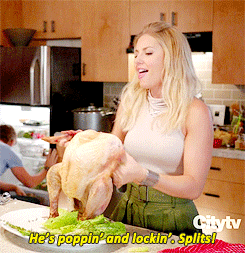
You don’t want to end up with so much turkey that you’re eating leftovers into the week following Thanksgiving (unless you want food poisoning). But you also don’t want guests to go hungry. A good rule of thumb for choosing the right-sized turkey is: one pound per eater.
-
Make a thaw plan.
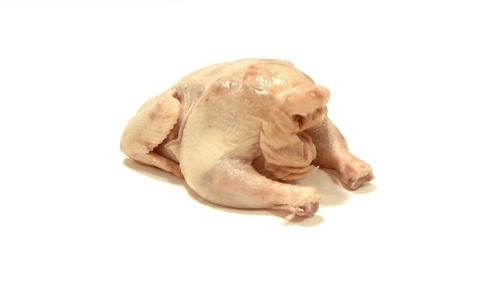
If you think you can pull a 20-pound turkey out of the freezer on Thanksgiving morning and still get it cooked and on the table in time for dinner, think again. When you agreed to host Thanksgiving, you may not have realized you signed up for a week-long process. A turkey takes three to five days to thaw in the fridge. To be exact, allocate one day for every four pounds of turkey. (We can hear you screaming, "I was told there'd be no math!" Sorry.)
-
Get up close and personal.

Here’s everyone’s most favorite or least favorite part depending on their personality. First things first: stick your hand up the turkey’s ass. Grab the giblets. Pull. You’ll get a gross handful of turkey anatomy, which you can save if you’re making your own gravy (good luck with that). Next, round up some paper towels and pat your turkey’s open orifice and skin dry. Whatever you do, don’t bathe your turkey. It’s actually unsanitary to do so and it wasn’t a dirty bird to begin with.
-
It’s brine time.
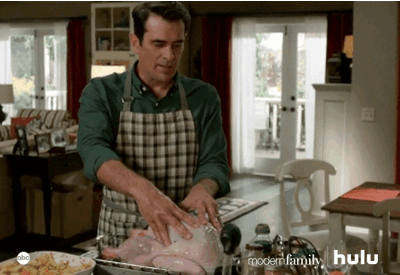
You can go wet or dry with the brine for your bird, but for simplicity’s sake, let’s stick with a dry brine. All you need are 6 tablespoons of salt; four for the exterior and two for the interior. Give your bird a nice, salty massage, then stick it back in the fridge for a day. If you want to get creative, you could also rub your turkey with some dried thyme, sage, and/or rosemary. (You so fancy.) Or just buy a premade turkey rub. No shame.
-
Don’t stuff the bird.
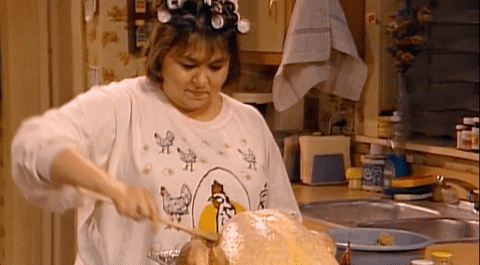
Sure, it seems like a time-saving, two-in-one cooking trick to bake the stuffing in the bird, but there’s a risk of transmitting bacteria this way, and considering the coronavirus pandemic, the last place you want to end up after Thanksgiving dinner is the emergency room. Cook the stuffing separately. Leave your bird hollow.
-
Pan it.

It’s time to transfer your turkey to its pan. This might be the only time you attempt to make a turkey (they really are a pain in the butt to prepare), so don’t bother buying a spendy roasting pan. Just get one of those disposable aluminum tubs that they sell at the grocery store. (It makes cleanup a lot easier, too.) Put your bird in, breasts up.
-
Babysit your bird.
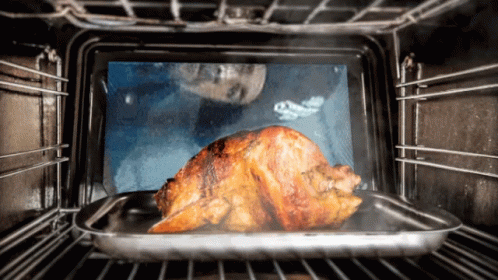
You’ll start your bird off at 425 degrees for 30 minutes. Then you’ll drop it down to 350 for the remainder of the cooking time. The average oven time for turkeys is 20 minutes per pound. But that’s just a guess. It almost always takes longer than you think it will, and, yes, that could mean all freakin’ day. The only way to know when your turkey is truly done is to take its temperature (no, not with a thermometer you use on humans; a meat thermometer, Einstein). When the temp in the thickest part of the bird hits 165 degrees, you’re golden.
-
Keep it moist.
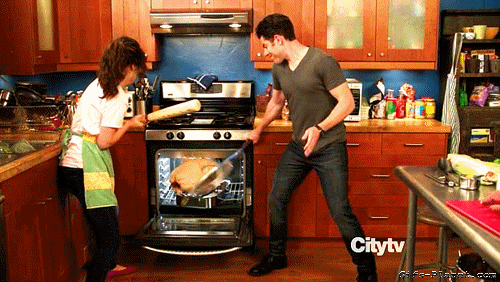
Every 30 minutes that your bird’s in the oven, you’re going to have to baste. The easiest way to do this is to suck up the bird’s own juices with a baster (or just a spoon if you’re broke) and distribute them over the bird’s skin. If you want to go the extra mile, you can also baste with melted butter, white wine, or even gravy.
-
Knives out.

It’s carving time! We recommend relying on YouTube for visual guidance so you don’t butcher your bird. Make sure you have a sharp carving knife, a large cutting board, and a serving platter at the ready before you begin.
-
Pig out.

All your hard work paid off! (And if it didn’t, that’s what pizza delivery is for.) Now it’s time to sit back, loosen your pants, and stuff yourself.





